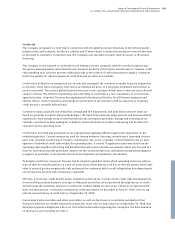Siemens 2008 Annual Report Download - page 291
Download and view the complete annual report
Please find page 291 of the 2008 Siemens annual report below. You can navigate through the pages in the report by either clicking on the pages listed below, or by using the keyword search tool below to find specific information within the annual report.
Notes to Consolidated Financial Statements 195
(in millions of €, except where otherwise stated and per share amounts)
Foreign exchange rate uctuations may create unwanted and unpredictable earnings and cash ow volatility.
Each Siemens unit conducting business with international counterparties that leads to future cash ows denom-
inated in a currency other than its functional currency is exposed to the risk from changes in foreign exchange
rates. The risk is mitigated by closing all types of business transactions (sales and procurement of products and
services as well as investment and nancing activities) mainly in the functional currency. In addition, the for-
eign currency exposure is partly balanced by purchasing of goods, commodities and services in the respective
currencies as well as production activities and other contributions along the value chain in the local markets.
Operating units are prohibited from borrowing or investing in foreign currencies on a speculative basis. Inter-
company nancing or investments of operating units are preferably done in their functional currency or on a
hedged basis.
Siemens has established a foreign exchange risk management system that has an established track record for
years. Each Siemens unit is responsible for recording, assessing, monitoring, reporting and hedging its foreign
currency transaction exposure. The binding guideline for Siemens segments and entities developed by the Cor-
porate Finance department, provides the concept for the identication and determination of the single net cur-
rency position and commits the units to hedge it in a narrow band: at least 75% but no more than 100% of their
net foreign currency exposure. In addition, the Corporate Finance department provides a framework of the
organizational structure necessary for foreign currency exchange management, proposes hedging strategies
and denes the hedging instruments available to the entities: forward contracts, currency put and call options
and stop-loss orders. Hedging transactions in the global nancial markets are carried out by SFS as exclusive
service provider for all Siemens entities on behalf of Corporate Treasury. SFS executes hedging instruments for
hedge accounting with external counterparts whereas for other hedging purposes Siemens has a Company-wide
portfolio approach which generate a benet from any potential off-set of divergent cash ows in the same cur-
rency, as well as optimized transaction costs. For additional information relating to the effect of this Company-
wide portfolio approach on the Consolidated Financial Statements, as well as for a discussion of hedging activi-
ties employed to mitigate or reduce foreign currency exchange risks, please refer to Note 32, “Derivative
nancial instruments and hedging activities”.
The foreign exchange rate sensitivity is calculated by aggregation of the net foreign exchange rate exposure.
The values and risks disclosed here are the unhedged positions multiplied by an assumed 10% depreciation of
the Euro against all other currencies. As of September 30, 2008, a parallel 10% positive shift of all foreign cur-
rencies would have resulted in a decline of €78 in future cash ows compared to a decline of €47 assuming a
10% negative shift of all foreign currencies in the year before. Such decline in Euro values of future cash ows
might reduce the unhedged portion of revenues, but would also decrease the not hedged portion of cost of
materials. The direction of the shift of the foreign currencies depends on whether the foreign currency inows
exceed the outows or not. Because at Siemens, the foreign currency outows exceed the inows as of Septem-
ber 30, 2008, a depreciation of the Euro against foreign currencies would have a negative nancial impact.
Future changes in the foreign exchange rates can impact sales prices and may lead to margin changes, the
extent of which is determined by the matching of foreign currency revenues and expenses.
Siemens denes foreign currency exposure generally as balance sheet items in addition to rm commitments
which are denominated in foreign currencies, as well as foreign currency denominated cash inows and cash
outows from anticipated transactions for the following three months. This foreign currency exposure is deter-
mined based on the respective functional currencies of the exposed Siemens’ entities.
























